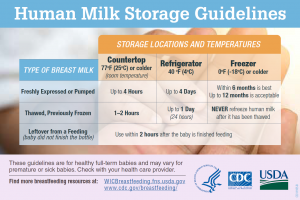Categories: Breastfeeding, Pumping, Working Mamas
June 9, 2022
Last updated on June 9, 2022
Whether you are heading back to work, school, running errands, or just want a little bit of a break, there may be times you will be away from baby. Following proper breastmilk storage guidelines is essential to maximize nutritional composition and maintain safety of breastmilk. If you are feeding your baby freshly expressed milk, thawing frozen milk, or a combination of the two, following these steps will enable your baby to receive the benefits of human milk.
Safe Handling
- Before expressing milk, wash hands thoroughly.
- Read pump manufacturer manual to learn how to properly wash the different parts and bottles. It is typically recommended to wash using hot, soapy water and air dry.
- If using a multi-user pump in a hospital setting or lactation room provided by your employer, clean pump dials, power switch, countertop, and any area needed with a disinfectant wipe.
Storing and Freezing Breastmilk
- Use breastmilk storage bags or clean, food-grade, BPA-free storage containers, such as glass, silicone, or plastic, that seal or have tight fitting lids.
- Clearly label milk with the date before storing. Rotate milk based on date expressed and stored, using the “first in, first out” rule.
- Do not store milk in the door of the refrigerator or freezer, to protect milk from temperature fluctuations.
- If you do not think you will use the milk within 4 days, freeze right away to help protect the nutritional quality of the milk.
- When freezing:
- Leave about one inch of space in the breastmilk storage bag to allow for expansion.
- Follow manufacturer guidelines for how to position storage bags (lay flat, stand upright, etc.) to avoid potential leaks.
- Store milk in 2 to 4-ounce portions to help reduce waste.
- Freshly expressed milk can be stored:
- At room temperature (77◦F or colder) for up to 4 hours.
- In the refrigerator for up to 4 days.
- In the freezer for about 6 months is best; up to 12 months is acceptable.

Thawing and Warming Breastmilk
- Run breastmilk storage bag under lukewarm water, place in a bowl of lukewarm water, or leave in refrigerator overnight to thaw.
- Do not microwave breastmilk, as this breaks down nutrients and creates hot spots, which can burn baby’s mouth.
- Swirl gently to mix.
- Milk can also be fed to baby directly from the refrigerator without being warmed.
- Leftover milk from a feeding should be used within 2 hours.
For more information, review the CDC’s guidelines for proper storage and preparation of breastmilk.


